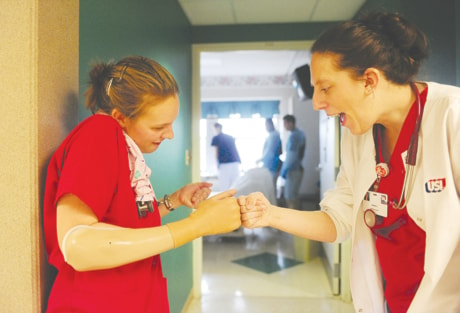EVANSVILLE, Ind. — It was a long, exhausting ride back to Evansville from summer vacation in Florida for Kelsey Weber Payne and her family. About halfway through the trip, she decided to take a quick nap before stopping in Atlanta to eat.
She was almost asleep when a semitrailer bumped the rear of the family’s van, sending the vehicle careening out of control across busy Interstate 75. Within a flash, her life was changed forever and her dream of becoming a nurse was almost jeopardized.
“Everything just went wrong,” said Weber Payne, recalling the July 2008 wreck. The impact pushed the van across three lanes of traffic into the path of a second semi, which also struck them. The van skidded across the same three lanes of traffic and flipped on its side.
“I guess from the impact of us hitting the ground, my arm went out the window, and from there the first semi that hit us shoved us down the highway 60 to 90 yards,” she said. “My hand was out the window the entire time.”
When the van stopped, Weber Payne looked down at her right hand to see it dangling. “It was bleeding, and knowing that I wanted to be a nurse, I kind of knew what to do already,” she said.
With her left arm, she retrieved a blanket from the van’s back and wrapped it around her right hand to slow the bleeding. She walked away from the wreckage, and a few minutes later, an ambulance sped her to Atlanta’s Piedmont Hospital emergency room. Her hand was nearly severed. After X-rays, she was wheeled into the operating room.
The operation lasted more than four hours. Surgeons spent the first three hours trying to save part of the hand and a few fingers but decided amputation was the best option, Weber Payne said. “After I came out of (the operating room), I obviously had no hand.”
She was released from the hospital about four days later.
Weber Payne, then a new high school graduate, had been accepted into the University of Southern Indiana’s nursing program.
She remembers meeting with USI’s dean of nursing after the accident and was told nursing would be extremely difficult, if not impossible, with only one hand.
“My mom and I were crying in the office and I was like, ‘Well, I’m going to do it anyway’,” Weber Payne said.
Nursing requires the ability to complete a wide range of tasks, including drawing medications into a syringe, administering shots, hanging IV bags and handling patients.
Weber Payne would need two hands to meet the challenge, which led her to Riverside Orthotics and Prosthetics in Evansville.
“She wanted a hand that would function like the hand she lost,” said prosthetist Tom Whitehurst. He recommended an i-Limb Plus, a high-tech replacement hand with more dexterity than a regular prosthetic could provide.
Whitehurst first fitted Weber Payne with a traditional hand hook prosthetic to give the muscles in the residual arm time to atrophy until the shape of the stub stabilized.
The body-powered hand hook prosthetic was very cumbersome and heavy. It had to be strapped around the chest with a harness across the opposite shoulder. The hook was limited to a pinch grip that opened and closed by moving the shoulder forward or backward.
Weber Payne used the prosthetic for about a year. In the meantime, Whitehurst contacted Touch Bionics in Columbus, Ohio, to explore the i-Lim, which had been on the market for less than two years and was the first hand prosthetic with individually powered fingers and thumb.
Whitehurst worked through several roadblocks to persuade Weber Payne’s insurance carrier to pay for the new prosthetic.
The insurance company twice denied coverage until Whitehurst was able to explain to their satisfaction why a nurse needed to be able to grip objects with two hands. Approval was finally granted and Weber Payne received the US$70,000 device in August, becoming one of only about 100 people with an i-Limb.
To use it, Weber Payne had to learn to move the flexor and extensor muscles in her arm individually to be able to control each finger and thumb on i-Limb.
Sensors inside the i-Limb socket are aligned with nerves in the arm muscle that fire, activating motors inside the device and causing the fingers and thumb to move.
Whitehurst said within minutes of putting on new prosthetic, Weber Payne had it figured out.
“You can pick up little, small things, like a pen or fork or spoon,” she said. “It’s not as good as an actual hand, obviously, but it gives you more dexterity because the fingers move independently.”
Weber Payne recently received a new flesh-coloured silicone covering to replace the clear glove used to protect the hand from moisture and damage. The covering looks more realistic, with fingernails that appear to be painted with clear nail polish.
The hand attracts a lot of attention at Deaconess Hospital in Evansville where Weber Payne, now a junior nursing student, is involved in clinical studies twice a week. She’s frequently asked about the prosthetic hand by patients and the hospital’s nursing staff.
“So, I tell the story of what happened, and I have the hand with me. And if they want to see it, I show it to them,” Weber Payne said. “They think it’s pretty cool.”
